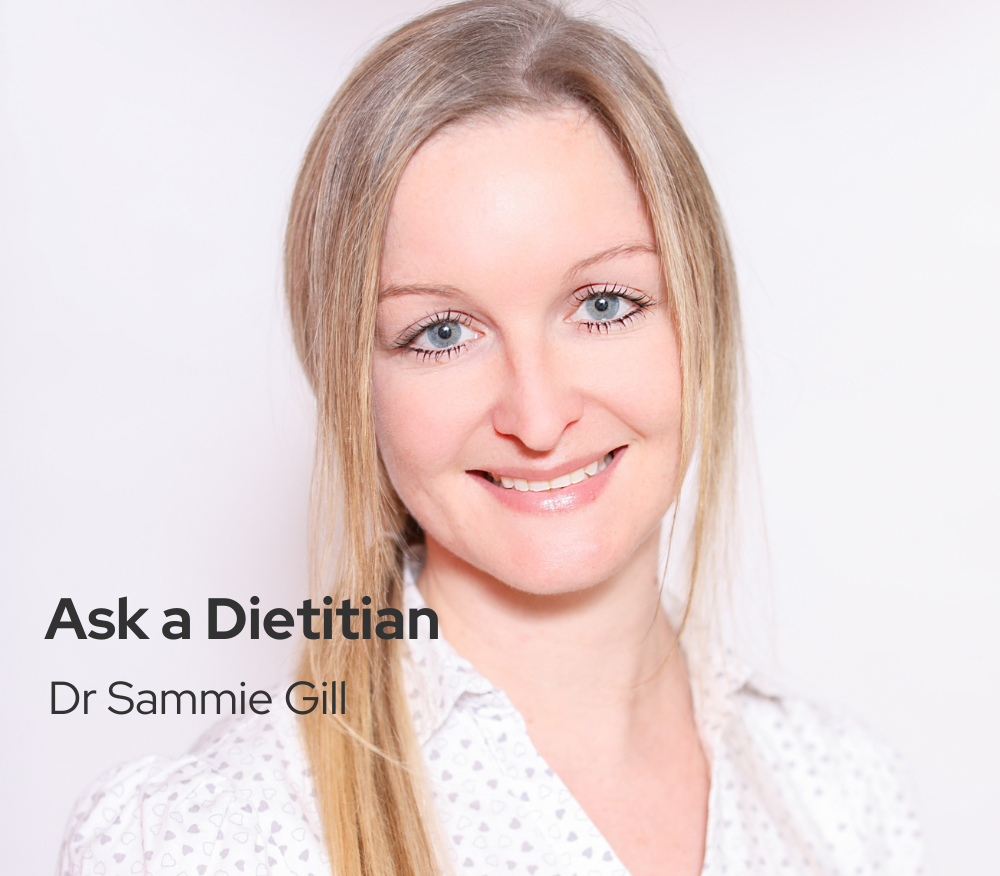Heard about the low-FODMAP diet but not really sure what it means or where to start? Gastroenterology Dietitian Dr Sammie Gill explains all.
What is the low-FODMAP diet?
The low-FODMAP diet was first coined in the early 2000’s, but it wasn’t until 2010 that the first randomised controlled trial was published.
The low-FODMAP diet is specifically for the management of irritable bowel syndrome (IBS). It can improve symptoms in approximately 50-80% of people, when administered appropriately under the guidance of a healthcare professional trained in the low-FODMAP diet (typically a specialist gastroenterology dietitian).
‘FODMAP’ stands for Fermentable Oligosaccharides, Disaccharides, Monosaccharides and Polyols.
In short, FODMAPs are a group of small, short-chain carbohydrates. When you eat foods containing these short-chain carbohydrates, they don’t get absorbed when they reach the gut – this happens in everyone, not just in people with IBS. But people with IBS are more likely to feel the effects of FODMAPs.
FODMAPs pull water into the gut and get rapidly broken down (fermented) by gut microbes, leading to symptoms such as pain, bloating, diarrhoea and/or constipation.
How does it work?
The low-FODMAP diet involves a three-stage process:
- Restriction of foods high in FODMAPs for 2-8 weeks to bring about symptom relief.
- Re-introduction of one group of FODMAPs at a time, testing different portion sizes to identify tolerance levels, and monitoring symptoms.
- Personalisation of the FODMAP diet that is tailored to you and enables long-term flexibility.
Here are some examples of high and low FODMAP foods:
Oligosaccharides
Fructans and galactooligosaccharides
High: Wheat/rye/barley-based breads/pasta/cereals, biscuits, crackers. Legumes (e.g. beans), garlic, onion, nuts (cashews, pistachio)
Low: Wheat/rye/barely-free breads/pasta/cereals, biscuits, crackers, oats, cornflakes, rice cakes, quinoa flakes. Legumes in small amounts, peanuts, walnuts
Disaccharides
Lactose (sugar in dairy foods)
High: Cow’s milk, ice cream, cream, soy milk (made from whole soybeans), custard, yogurts, some cheeses (e.g. cheese spreads, mozzarella, cottage cheese)
Low: Almond milk, soy milk (made from soy protein), hemp milk, rice milk, coconut milk, lactose-free milk, hard cheeses, brie/camembert, feta cheese
Monosaccharides
Fructose (sugar in fruit)
High: Apples, pears, cherries, mango, plums, watermelon
Low: Oranges, kiwis, pineapple, cantaloupe, unripe bananas, strawberries
Polyols
Sorbitol and mannitol
High: Honey, sugar-free sweets, high fructose corn syrup
Low: Maple syrup, table sugar
What else do I need to consider?
- The low-FODMAP diet is not a long-term diet. The restriction stage is a maximum of 8 weeks long (it’s often a lot shorter than that).
- The low-FODMAP diet is not a low carb diet – it only restricts certain short-chain carbohydrates that have been shown to worsen symptoms of IBS.
- The low-FODMAP diet is often considered a complicated and challenging diet to follow. An alternative to the low FODMAP diet is the FODMAP ‘gentle’, ‘lite’ or ‘simplified’ approach. Seek support from a healthcare professional who can guide you through the process. This is to prevent over-restriction and possible nutrient deficiencies, lessen any potential negative effects on the gut microbiome, and offer the best chance of symptom management.
- Approximately 20-50% of people will not respond to the low FODMAP diet. If you are one of them, seek support from a specialist gastroenterology dietitian who can help with alternative IBS management approaches.
Remember, different approaches work for different people. It’s important to test each IBS management approach separately so you can accurately gauge whether it has helped with your symptoms.
Try completing a detailed 2–4-week food and fluid diary, alongside monitoring symptoms. This can be a good place to start to help tease out patterns.
Dig into some low-FODMAP recipes:
Crispy Sausage and Swede Pasta by Emma Hatcher
Greek Salad by Emma Hatcher
Veg-Packed Curry with Crispy Chickpeas and Paneer
Tomato, Courgette and Ricotta Tart
Summer Chicken & Veg Traybake with Basil Pesto
Orange and Rhubarb Snack Bars by Emma Hatcher






